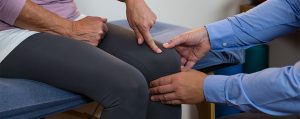I’m A Physical Therapist And These Are My Go-To Essentials For Practicing Self-Care
Posted on by Tanner Neuberger, PT, DPT, TDN Level 1
Let’s face it, life can be stressful. Whether it’s stress from work, home, friends, etc., it can come from anywhere. It can trigger us to start choosing bad habits, and these bad habits can add up over time, becoming detrimental to our health. The higher amounts of stress that someone has, the higher the likelihood that they will have some form of mental and physical health issues. In an effort to stave off these possible negative outcomes, it is important that we practice some self-care in order to decrease our stress levels to a manageable degree. As a physical therapist, here are my go-to essentials for practicing self-care.
(more…)
Are Your Flip Flops Causing Your Foot Pain?
Posted on by Tara Hackney, PT, DPT, OCS, KTTP
Flip flops and sandals are popular summer shoe options. However, these shoes often sacrifice support for an open toe. With many people wearing less supportive shoes in the summer months, foot injury rates may appear to increase during this time. Plantar fasciitis is a common foot condition that can affect people of all ages and we may see a higher rate of plantar fasciitis during the summertime.
(more…)
An All-Ages Hip Workout Anyone Can Do
Posted on by Brandon Bowers, PT, DPT, Astym Cert.
It’s all in the hips! Have your hips been feeling weak lately? Or maybe someone has told you to strengthen your hips, but you’re not sure how? Look no further – here are five hip exercises anyone can do, regardless of age or activity level.
(more…)
Physical Therapy For Chronic Pain: Why It’s Never Too Late To Seek Help
Posted on by Clinton Boone, PT, DPT, CMTPT/DN
Living with chronic pain can affect every aspect of your life. It can be debilitating and overwhelming. However, physical therapy offers hope and a solution for those suffering from chronic pain. Regardless of how long you've been enduring pain, it's never too late to seek help. Physical therapy is a worthwhile option. It may improve your quality of life no matter how long you have been struggling with pain.
(more…)
Beginning Strength Training For Seniors And Tips For Building A Consistent Routine
Posted on by Tanner Neuberger, PT, DPT, TDN Level 1
Every second of the day, someone aged 65 or older will fall. 36 million falls will occur annually, and this accounts for 95% of hip fractures in the U.S. Strength training is a relatively easy way to help decrease a person’s fall risk, and positively affect many different aspects of their life. Starting a new strength training routine can be an easy thing, albeit sometimes scary, to add to your schedule to make sure you reduce your risk of age-related ailments and maladies. There is a lot of information that exists in the resistance training world, and sometimes it can be daunting to get started when there is a plethora of information out there of what is “best” or “optimal”. This article looks to simplify the process for you, as well as give you tips for building consistency in your routine.
(more…)
6 Ways To Safely Improve Stamina For Runners
Posted on by Andrew Cassidy, PT, DPT
Stamina and endurance are often used as interchangeable descriptors in the world of endurance sports. ‘Runners are known for impressive stamina’ or ‘Triathletes train their bodies for maximal endurance’ are synonymous on the surface. However, stamina and endurance do not have the same technical meaning. Stamina relates to an individual’s ability to sustain peak energy output. Endurance relates to the length of time an individual can sustain moderate level activity.
(more…)
Returning to Exercise After ACL Surgery
Posted on by Owen Campbell, PT, DPT, OCS
Having an ACL reconstruction can throw a major wrench into your life. The surgery is complicated, and the rehab program can feel daunting. With a projected return to sport timeline hovering around 9 months to a year depending on your injury, it can feel like you are destined for a year of struggle.
This is a common concern before surgery, and a common fear in the first few weeks after surgery. Your knee is swollen, walking is a chore, and sometimes you even need to wear a big bulky brace. The good news is, with proper rehabilitation, you should be back to the gym in a much shorter timeframe.
(more…)
4 Stress-Relieving Exercises For Teens And Students That Can Be Done At School
Posted on by Paige Gibbens, PT, DPT, MHA
Stress is defined by the World Health Organization as “a state of worry or mental tension caused by a difficult situation.” Stress occurs throughout life, for everyone. Stress is how a human responds and protects from challenges or threats. Stress can be a way to help people or things to grow stronger, but in moderation. There are many simple stress relieving techniques that can be utilized during the school day to help improve your day! Below are five simple tips and exercises for improving stress levels that can be done anywhere.
(more…)
